Characteristics of Soil Physical Properties and Spatial Distribution of Soil Erosion on Ridge-Slope Farmland in the Black Soil Areas of Northeast China
Abstract
1. Introduction
- (i)
- To define the spatial distribution of soil water-holding capacity, soil structure characteristics, and the annual average soil loss for RW and CK.
- (ii)
- To evaluate the benefits of improved soil physical properties in RW compared to CK and to quantify and analyze the differences in spatial distribution between the two.
2. Materials and Methods
2.1. General Description of the Study Area
2.2. Research Methodology
2.3. Indicator Measurement and Methodology
2.4. Calculation of the Annual Average Soil Loss
2.5. Data Analysis
3. Results and Discussion
3.1. Soil Bulk Density and Soil Porosity
3.2. Soil Water-Holding Capacity
3.3. Soil Aggregate Stability
3.4. The Annual Average Soil Loss
3.5. Comprehensive Evaluation of Soil Physical Properties
4. Conclusions
Author Contributions
Funding
Institutional Review Board Statement
Informed Consent Statement
Data Availability Statement
Acknowledgments
Conflicts of Interest
References
- Teshome, A.; Rolker, D.; de Graaff, J. Financial viability of soil and water conservation technologies in northwestern Ethiopian highlands. Appl. Geogr. 2013, 37, 139–149. [Google Scholar] [CrossRef]
- Taye, G.; Poesen, J.; Vanmaercke, M.; Van Wesemael, B.; Martens, L.; Teka, D.; Hallet, V. Evolution of the effectiveness of stone bunds and trenches in reducing runoff and soil loss in the semi-arid Ethiopian highlands. Z. Für Geomorphol. 2015, 59, 477–493. [Google Scholar] [CrossRef]
- Haile, M.; Herweg, K.; Stillhardt, B. Sustainable Land Management–A New Approach to Soil and Water Conservation in Ethiopia. Land Resources Management and Environmental Protection Department; Mekelle University: Mekelle, Ethiopia, 2006. [Google Scholar]
- Ogden, J.C. Everglades ridge and slough conceptual ecological model. Wetlands 2005, 25, 810–820. [Google Scholar] [CrossRef]
- Kabala, C.; Bojko, O.; Medynska, A.; Szczepaniak, A. Spatial variability and temporal changes in the heavy metal content of soils with a deep furrow-and-ridge microrelief formed by an afforestation plowing. Environ. Monit. Assess. 2013, 185, 5141–5150. [Google Scholar] [CrossRef] [PubMed][Green Version]
- Sudhishri, S.; Dass, A.; Lenka, N.K. Efficacy of vegetative barriers for rehabilitation of degraded hill slopes in eastern India. Soil Tillage Res. 2008, 99, 98–107. [Google Scholar] [CrossRef]
- Song, C.; Qu, Y.; Zhang, X.; Chen, Q.; Du, S. Retrospect of contour bund for soil and water conservation. Soils Crops 2018, 7, 1–12. (In Chinese) [Google Scholar] [CrossRef]
- Wang, Z.; Li, H.; He, X. Study on soil anti-erosion and anti-scour of prickly ash at edges of terraces in drought upland of Weibei. Res. Soil Water Conserv. 2000, 7, 33–37. (In Chinese) [Google Scholar]
- Yuan, D.; Wang, Z.; Chen, X.; Guo, X.; Zhang, R. Properties of soil and water loss from slope field in red soil in different farming systems. J. Soil Water Conserv. 2001, 15, 66–69. (In Chinese) [Google Scholar] [CrossRef]
- Zhao, P.; Tang, X.; Tang, J.; Zhu, B. The nitrogen loss flushing mechanism in sloping farmlands of shallow Entisol in southwestern China: A study of the water source effect. Arab. J. Geosci. 2015, 8, 10325–10337. [Google Scholar] [CrossRef]
- Zhao, Q.; Li, D.; Zhuo, M.; Guo, T.; Liao, Y.; Xie, Z. Effects of rainfall intensity and slope gradient on erosion characteristics of the red soil slope. Stoch. Environ. Res. Risk Assess. 2015, 29, 609–621. [Google Scholar] [CrossRef]
- USDA. Soil Survey Manual; Soil Survey Division Staff; Soil Conservation Service; Volume Handbook 18; U.S. Department of Agriculture: Washington, DC, USA, 1951.
- Moreno-Maroto, J.M.; Alonso-Azcárate, J. Evaluation of the USDA soil texture triangle through Atterberg limits and an alternative classification system. Appl. Clay Sci. 2022, 229, 106689. [Google Scholar] [CrossRef]
- Dong, L.G. Methods for determination of several soil physical properties by in situ soil samples. Ningxia Agric. Sci. Technol. 2019, 60, 51–52. (In Chinese) [Google Scholar]
- Zhang, Y.Y. Determination of field water holding capacity and error analysis in the east Yudong plain area. Henan Water Conserv. South-North Water Divers. 2023, 52, 20–22. (In Chinese) [Google Scholar]
- Haiou, Z.; Zhen, G.; Chendi, S.; Juan, L. Distribution characteristics and stability of soil aggregates as compounded by soft rock and sand under different planting years of corn in Mu Us sandy land in China. Bangladesh J. Bot. 2021, 50, 917–923. [Google Scholar] [CrossRef]
- Dıaz-Zorita, M.; Perfect, E.; Grove, J.H. Disruptive methods for assessing soil structure. Soil Tillage Res. 2002, 64, 3–22. [Google Scholar] [CrossRef]
- Tagar, A.A.; Adamowski, J.; Memon, M.S.; Do, M.C.; Mashori, A.S.; Soomro, A.S.; Bhayo, W.A. Soil fragmentation and aggregate stability as affected by conventional tillage implements and relations with fractal dimensions. Soil Tillage Res. 2020, 197, 104494. [Google Scholar] [CrossRef]
- Liu, B.Y.; Zhang, K.L.; Xie, Y. An empirical soil loss equation. In Proceedings of the 12th International Soil Conservation Organization Conference, Beijing, China, 26–31 May 2002; pp. 26–31. [Google Scholar]
- Yu, B.; Rosewell, C.J. An assessment of a daily rainfall erosivity model for New South Wales. Soil Res. 1996, 34, 139–152. [Google Scholar] [CrossRef]
- Zhang, Y.B.; Xie, Y.; Liu, B.Y. A study on the method of calculating the erosive power of rainfall using daily rainfall. Geoscience 2002, 6, 705–711. [Google Scholar]
- Williams, J.R. Epic-erosion/productivity impact calculator: 1. model documentation. Tech. Bull. United States Dep. Agric. 1990, 4, 206–207. [Google Scholar] [CrossRef]
- Sharpley, A.N. EPIC—Erosion/Productivity Impact Calculator: 1. Model Documentation; Sharpley, A.N., Williams, J.R., Eds.; Technical Bulletin No. 1768; US Department of Agriculture: Washington, DC, USA, 1990.
- Liu, B.Y.; Nearing, M.A.; Risse, L.M. Slope gradient effects on soil loss for steep slopes. Trans. ASAE 1994, 37, 1835–1840. [Google Scholar] [CrossRef]
- McCool, D.K.; Foster, G.R.; Weesies, G.A. Slope length and steepness factors (LS). In Predicting Soil Erosion by Water: A Guide to Conservation Planning with the Revised Universal Soil Loss Equation (RUSLE); US Department of Agriculture: Washington, DC, USA, 1997; Volume 703. [Google Scholar]
- Fu, S.H.; Liu, B.Y.; Zhou, G.Y. A tool for calculating slope length and gradient factor. Soil Water Conserv. Sci. China 2015, 13, 105–110. [Google Scholar] [CrossRef]
- Soil and Water Conservation Monitoring Centre of Ministry of Water Resources. Technical Provisions on Dynamic Monitoring of Regional Soil and Water Erosion (Trial); Ministry of Water Resources of the People’s Republic of China: Beijing, China, 2018; pp. 11–15. (In Chinese)
- SL 190-2007; Soil Erosion Intensity Grading Standard. Ministry of Water Resources of the People’s Public of China, China Water and Power Press: Beijing, China, 2008.
- Li, H.; Chen, Y.; Liu, X.; Liu, Y.; Du, Y. Factors affecting the soil erosion and scouring resistance of bank hedgerows in purple soil sloping cropland. Acta Prataculturae Sin. 2023, 32, 40–52. (In Chinese) [Google Scholar] [CrossRef]
- Liu, X.; He, B.; Li, Z.; Zhang, J.; Wang, L.; Wang, Z. Influence of land terracing on agricultural and ecological environment in the loess plateau regions of China. Environ. Earth Sci. 2011, 62, 797–807. [Google Scholar] [CrossRef]
- Zhang, X.; Zhao, W.; Wang, L.; Liu, Y.; Liu, Y.; Feng, Q. Relationship between soil water content and soil particle size on typical slopes of the Loess Plateau during a drought year. Sci. Total Environ. 2019, 648, 943–954. [Google Scholar] [CrossRef] [PubMed]
- Gregory, P.J.; Wojciechowski, T. Root systems of major tropical root and tuber crops: Root architecture, size, and growth and initiation of storage organs. Adv. Agron. 2020, 161, 917–923. [Google Scholar] [CrossRef]
- Backnäs, S.; Laine-Kaulio, H.; Kløve, B. Phosphorus forms and related soil chemistry in preferential flowpaths and the soil matrix of a forested podzolic till soil profile. Geoderma 2012, 189, 50–64. [Google Scholar] [CrossRef]
- Niemeyer, R.J.; Fremier, A.K.; Heinse, R.; Chávez, W.; DeClerck, F.A. Woody vegetation increases saturated hydraulic conductivity in dry tropical Nicaragua. Vadose Zone J. 2014, 13, vzj2013-01. [Google Scholar] [CrossRef]
- Hendrickx, J.M.; Flury, M. Uniform and preferential flow mechanisms in the vadose zone. Concept. Models Flow Transp. Fract. Vadose Zone 2001, 149–187. [Google Scholar]
- Jarvis, N.J. A review of non-equilibrium water flow and solute transport in soil macropores: Principles, controlling factors and consequences for water quality. Eur. J. Soil Sci. 2020, 71, 279–302. [Google Scholar] [CrossRef]
- Wei, W.; Chen, D.; Wang, L.; Daryanto, S.; Chen, L.; Yu, Y.; Lu, Y.; Sun, G.; Feng, T. Global synthesis of the classifications, distributions, benefits, and issues of terracing. Earth-Sci. Rev. 2016, 159, 388–403. [Google Scholar] [CrossRef]
- Han, J.; Ge, W.; Hei, Z.; Cong, C.; Ma, C.; Xie, M.; Liu, B.; Feng, W.; Wang, F.; Jiao, J. Agricultural land use and management weaken the soil erosion induced by extreme rainstorms. Agric. Ecosyst. Environ. 2020, 301, 107047. [Google Scholar] [CrossRef]
- Fernandes, F. Study application of soil conservation techniques along highway openings. J. Teknol. Pangan Dan Ilmu Pertan. 2024, 2, 43–50. [Google Scholar] [CrossRef]
- Li, Y.; Wang, K.; Liu, Z.; Wang, J.; Zhou, X. Effect of measure of engineering preparation to soil water in Yunnan dry-hot river valley. J. Soil Water Conserv. 2006, 1, 15–19. [Google Scholar] [CrossRef]
- He, J.; Cai, Q.; Fang, H.; Chen, X. Effect evaluation of spatial allocation of water and soil conservation measures in Zhangjiakou area. Trans. Chin. Soc. Agric. Eng. 2009, 25, 69–75. [Google Scholar] [CrossRef]
- Courtwright, J.; Findlay, S.E. Effects of microtopography on hydrology, physicochemistry, and vegetation in a tidal swamp of the Hudson River. Wetlands 2011, 31, 239–249. [Google Scholar] [CrossRef]
- Appels, W.M.; Bogaart, P.W.; van der Zee, S.E. Influence of spatial variations of microtopography and infiltration on surface runoff and field scale hydrological connectivity. Adv. Water Resour. 2011, 34, 303–313. [Google Scholar] [CrossRef]
- Adgo, E.; Teshome, A.; Mati, B. Impacts of long-term soil and water conservation on agricultural productivity: The case of Anjenie watershed, Ethiopia. Agric. Water Manag. 2013, 117, 55–61. [Google Scholar] [CrossRef]
- Rockström, J.; Falkenmark, M. Agriculture: Increase water harvesting in Africa. Nature 2015, 519, 283–285. [Google Scholar] [CrossRef]
- Díaz, A.R.; Sanleandro, P.M.; Soriano, A.S.; Serrato, F.B.; Faulkner, H. The causes of piping in a set of abandoned agricultural terraces in southeast Spain. Catena 2007, 69, 282–293. [Google Scholar] [CrossRef]
- Thompson, S.E.; Katul, G.G.; Porporato, A. Role of microtopography in rainfall-runoff partitioning: An analysis using idealized geometry. Water Resour. Res. 2010, 46, 7. [Google Scholar] [CrossRef]
- Moges, A.; Holden, N.M. Soil fertility in relation to slope position and agricultural land use: A case study of Umbulo catchment in southern Ethiopia. Environ. Manag. 2008, 42, 753–763. [Google Scholar] [CrossRef] [PubMed]
- Munkholm, L.J. Soil friability: A review of the concept, assessment and effects of soil properties and management. Geoderma 2011, 167, 236–246. [Google Scholar] [CrossRef]
- Zhang, Y.; Wu, T. Effects of water temperature on soil aggregate stability between soils developed from different parent materials in the subtropical hilly area of China. Catena 2024, 241, 108080. [Google Scholar] [CrossRef]
- Zheng, H.; Nie, X.; Liu, Z.; Mo, M.; Song, Y. Identifying optimal ridge practices under different rainfall types on runoff and soil loss from sloping farmland in a humid subtropical region of Southern China. Agric. Water Manag. 2021, 255, 107043. [Google Scholar] [CrossRef]
- Vermang, J.; Norton, L.D.; Huang, C.; Cornelis, W.M.; Da Silva, A.M.; Gabriels, D. Characterization of soil surface roughness effects on runoff and soil erosion rates under simulated rainfall. Soil Sci. Soc. Am. J. 2015, 79, 903–916. [Google Scholar] [CrossRef]
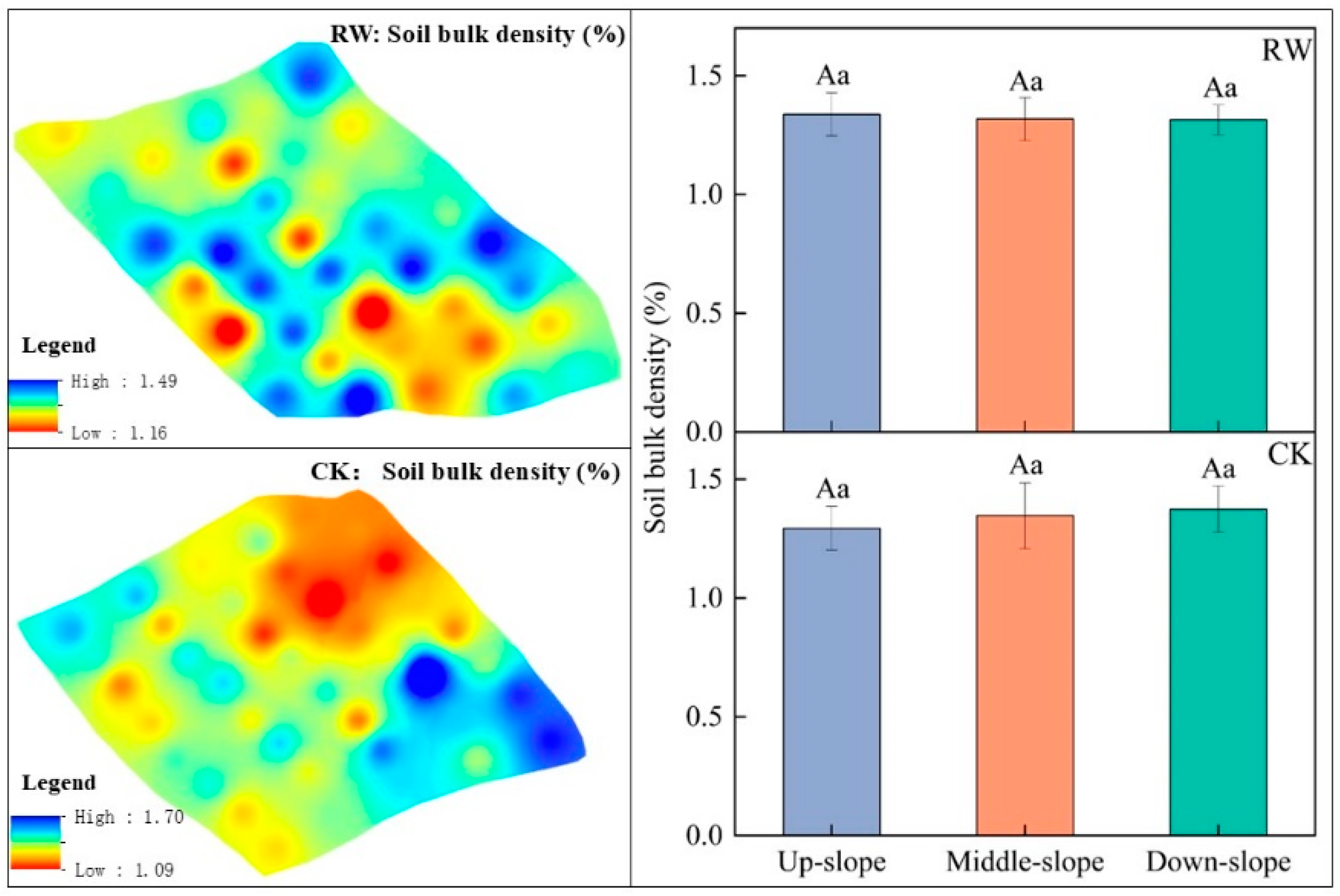
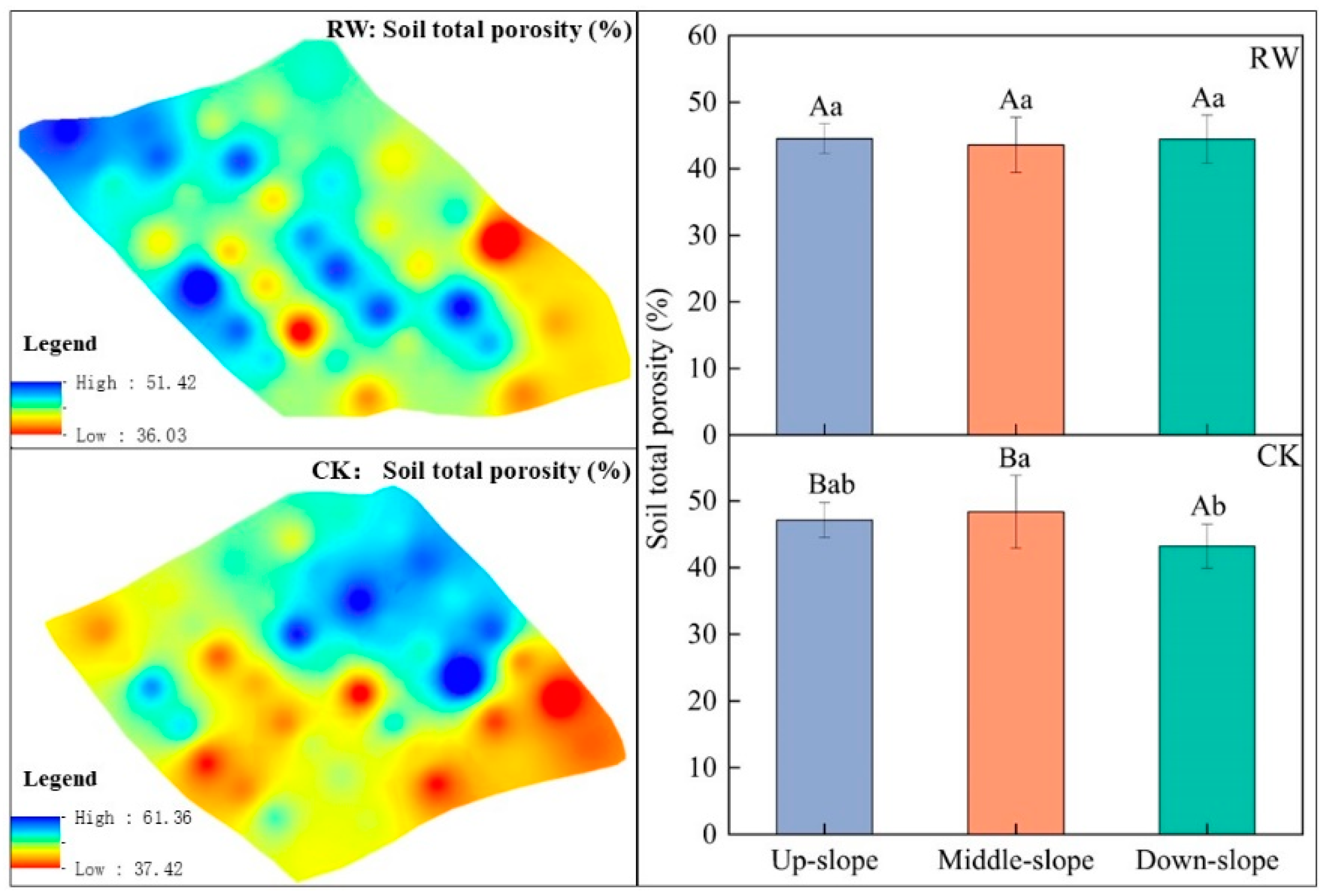
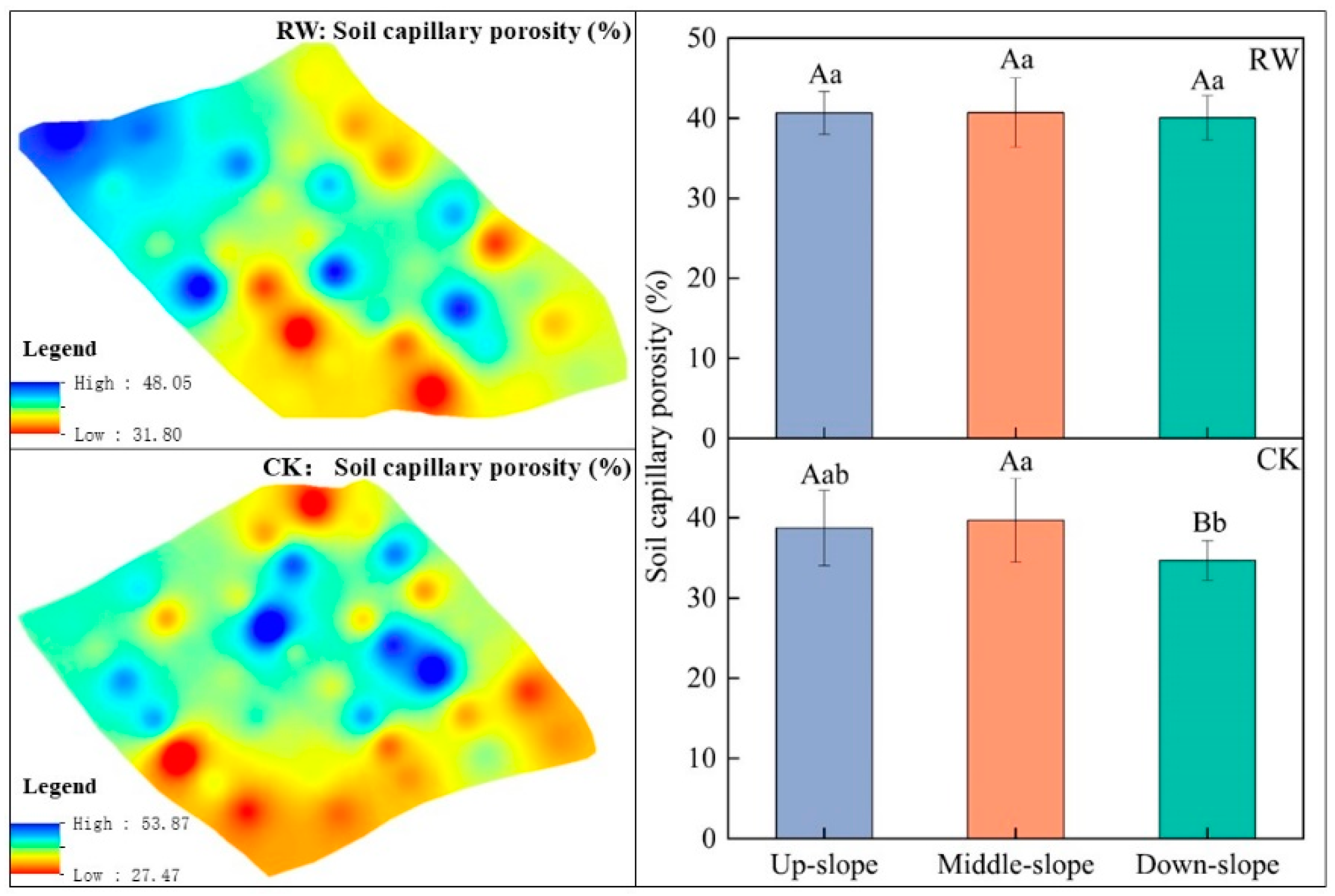


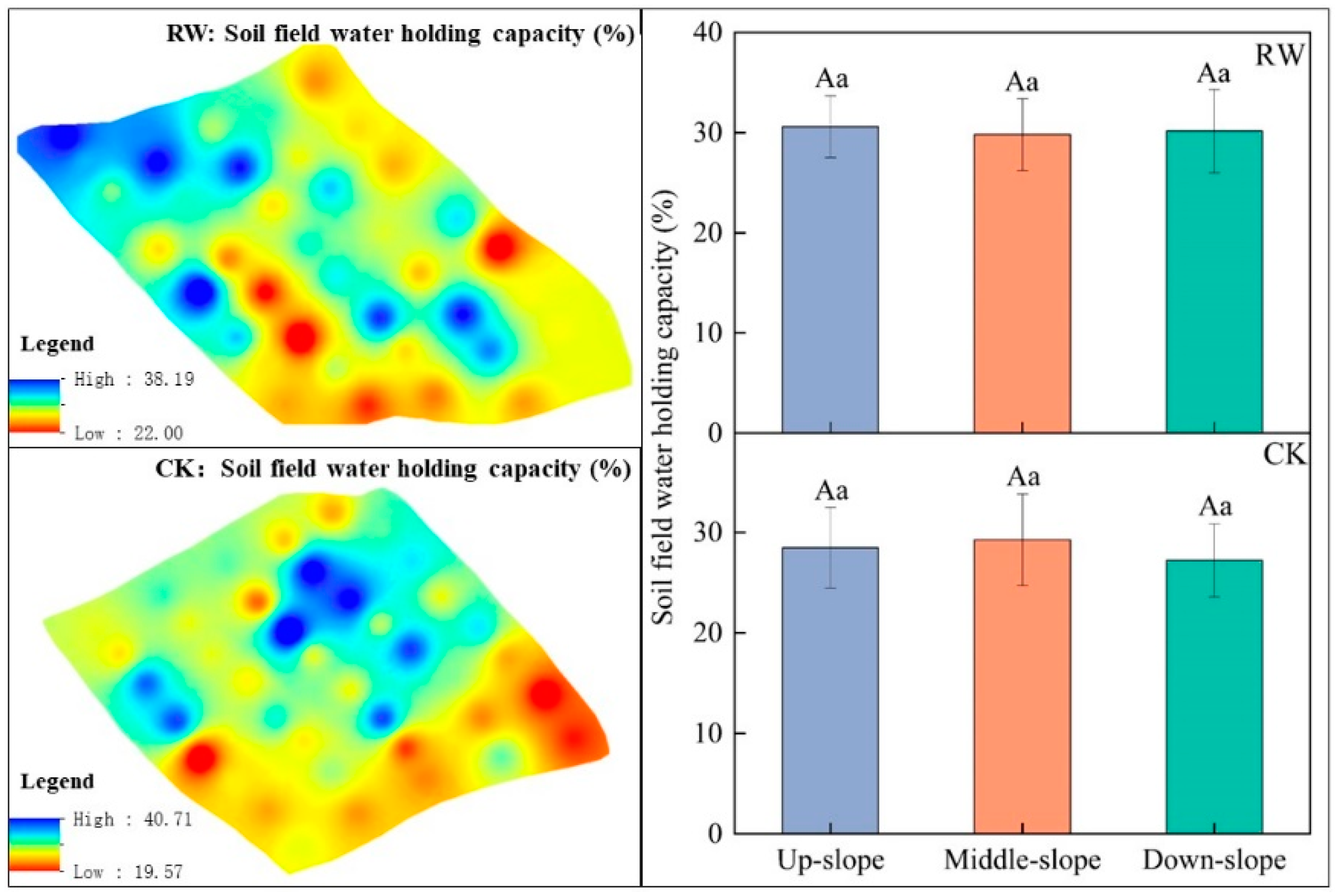
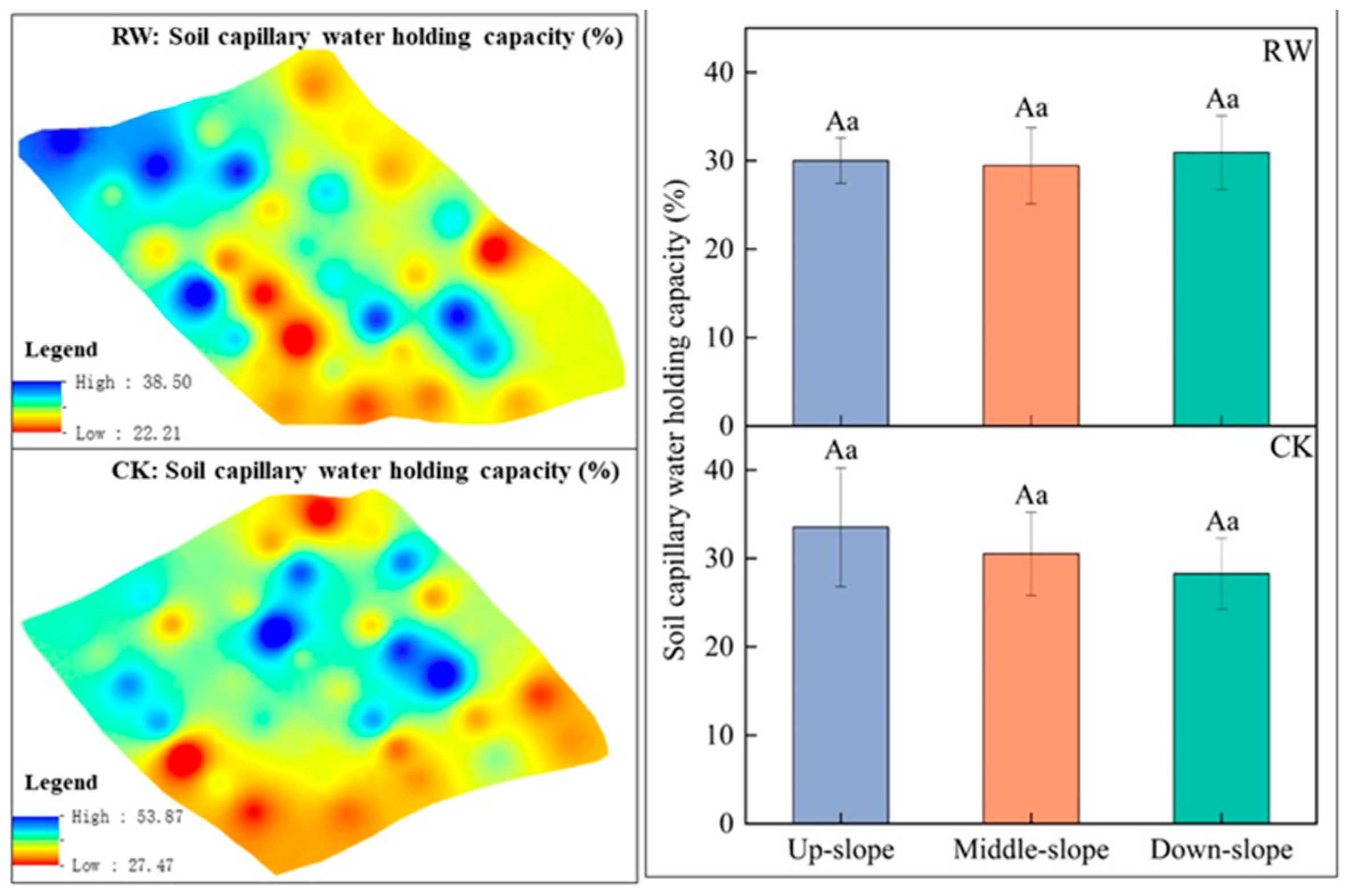
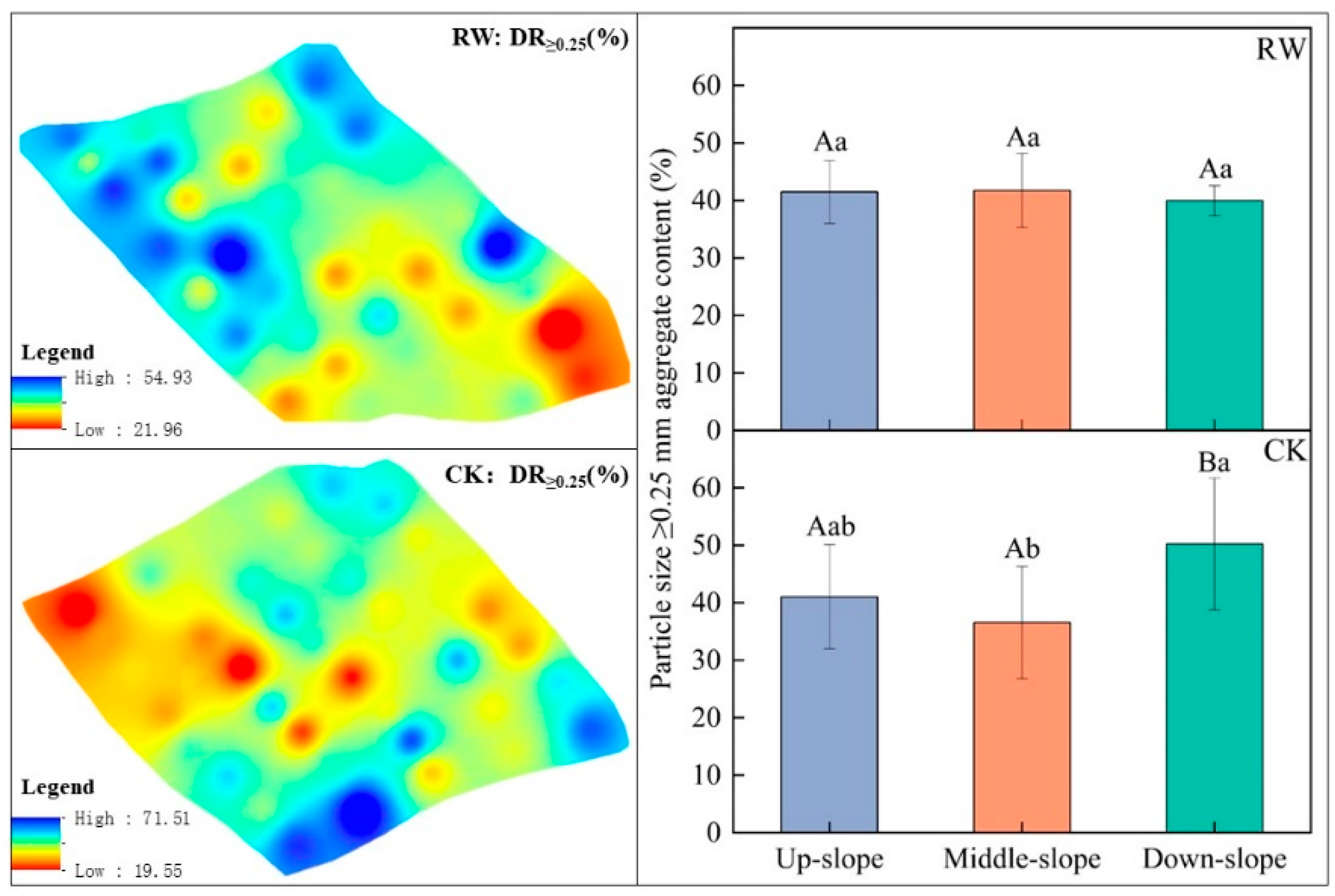



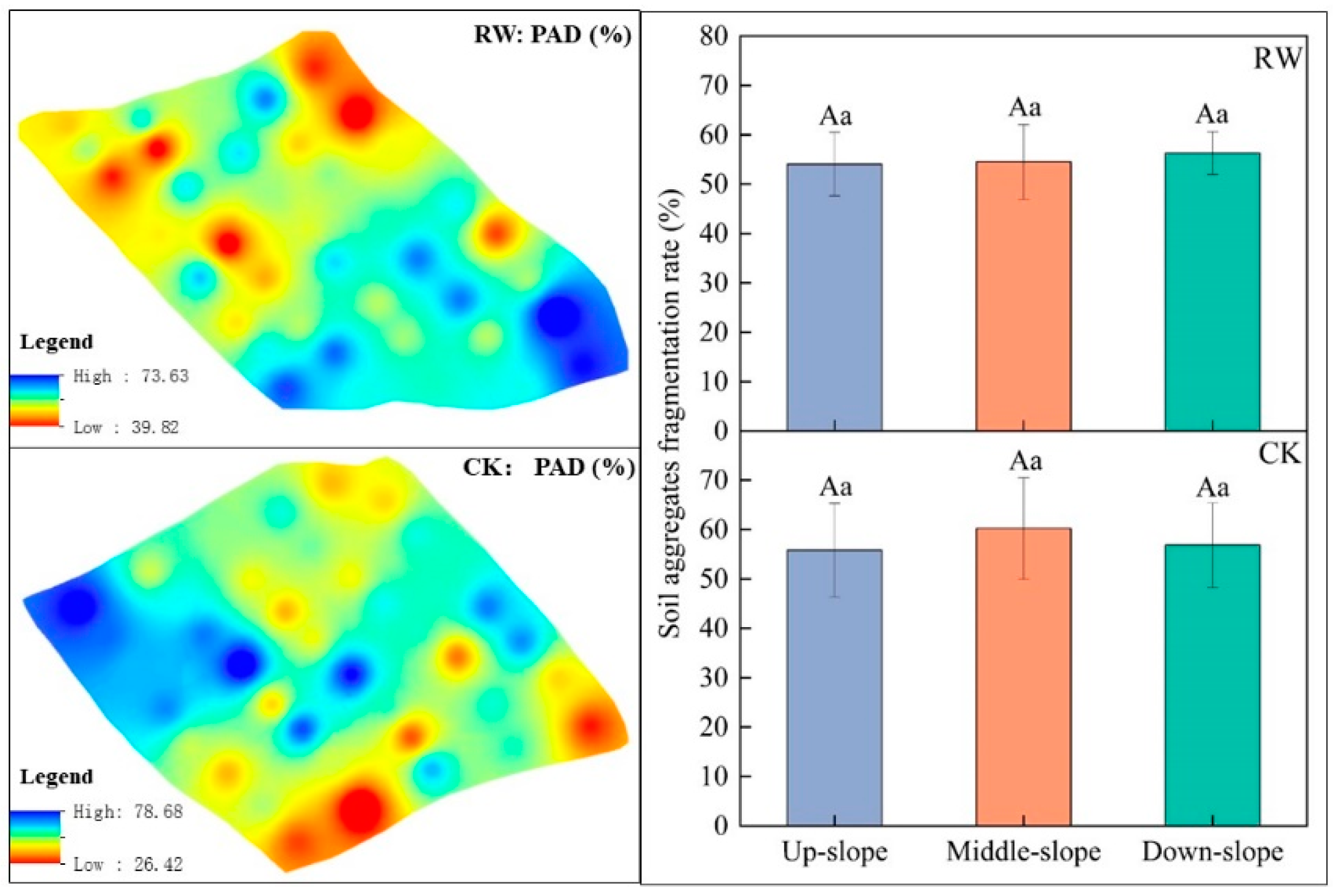

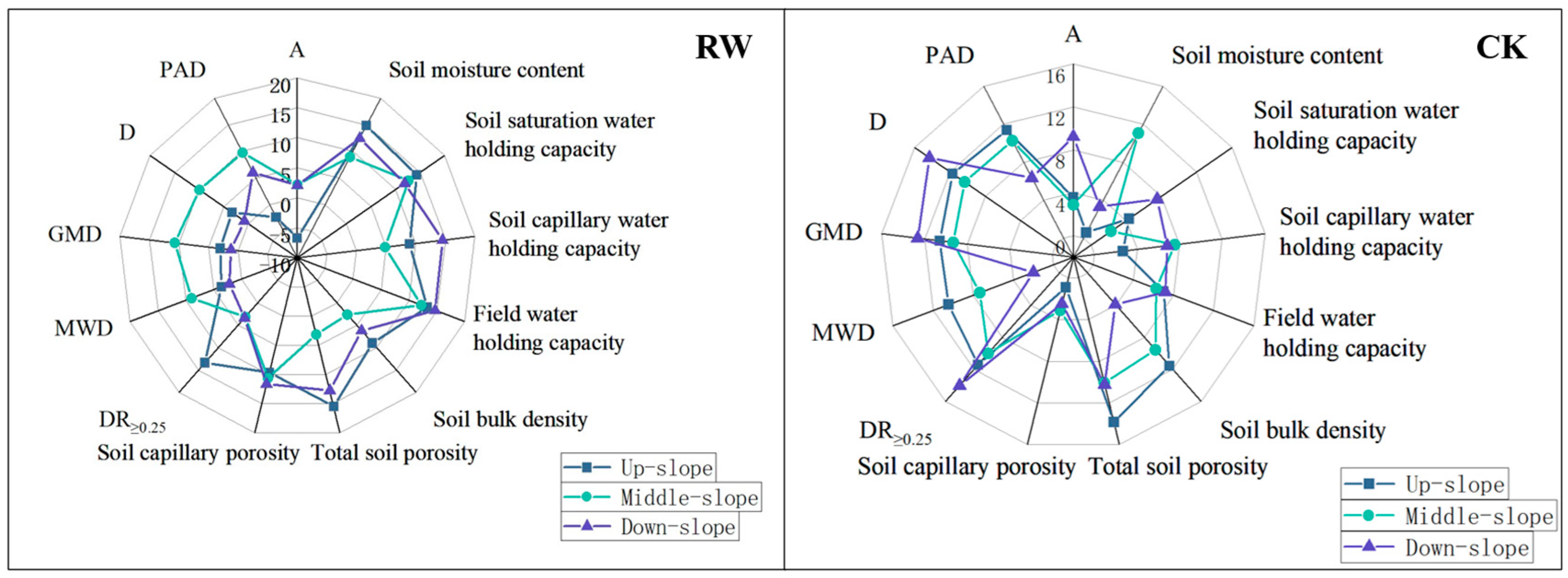

| Slope Type | Soil Texture | Slope (°) | Slope Length (m) | Area (m2) | Crops | Ridge Type | Ridge Height (m) | Number of Strips | Distance between Ridges |
|---|---|---|---|---|---|---|---|---|---|
| RW | Clay loam | 5~8° | 120 | 9563.5 | Corns | Woven bags | 0.5–0.8 m | 4 | 23–30 m |
| CK | 5~8° | 120 | 9071.6 | Corns | None | None | None | None |
| Sites | Position | R(MJ·mm/(ha·h·a)) | K(t·ha·h/(ha·MJ·mm)) | L | S | B | E | T | A (t/ha) |
|---|---|---|---|---|---|---|---|---|---|
| RW | Up-slope | 366.97 | 0.38–0.42 | 0.09–0.30 | 0.73–6.11 | 0.23 | 0.35 | 0.33 | 0.51–3.35 |
| Middle-slope | 0.34–0.42 | 0.02–0.17 | 3.02–10.20 | 0.86–3.35 | |||||
| Down-slope | 0.34–0.41 | 0.07–0.19 | 2.18–8.62 | 1.49–3.53 | |||||
| CK | Up-slope | 366.97 | 0.35–0.40 | 0.01–0.17 | 3.27–10.83 | 0.23 | 0.62 | 0.33 | 0.56–5.88 |
| Middle-slope | 0.35–0.41 | 0.01–0.17 | 3.27–10.83 | 0.56–7.26 | |||||
| Down-slope | 0.35–0.40 | 0.00–0.38 | 8.91–10.75 | 0.01–26.10 |
Disclaimer/Publisher’s Note: The statements, opinions and data contained in all publications are solely those of the individual author(s) and contributor(s) and not of MDPI and/or the editor(s). MDPI and/or the editor(s) disclaim responsibility for any injury to people or property resulting from any ideas, methods, instructions or products referred to in the content. |
© 2024 by the authors. Licensee MDPI, Basel, Switzerland. This article is an open access article distributed under the terms and conditions of the Creative Commons Attribution (CC BY) license (https://creativecommons.org/licenses/by/4.0/).
Share and Cite
Wei, S.; Fu, Y.; Liu, B.; Zhang, Y.; Shao, S.; Zhang, X. Characteristics of Soil Physical Properties and Spatial Distribution of Soil Erosion on Ridge-Slope Farmland in the Black Soil Areas of Northeast China. Water 2024, 16, 2353. https://doi.org/10.3390/w16162353
Wei S, Fu Y, Liu B, Zhang Y, Shao S, Zhang X. Characteristics of Soil Physical Properties and Spatial Distribution of Soil Erosion on Ridge-Slope Farmland in the Black Soil Areas of Northeast China. Water. 2024; 16(16):2353. https://doi.org/10.3390/w16162353
Chicago/Turabian StyleWei, Siyu, Yu Fu, Binhui Liu, Yanling Zhang, Shuai Shao, and Xiaoya Zhang. 2024. "Characteristics of Soil Physical Properties and Spatial Distribution of Soil Erosion on Ridge-Slope Farmland in the Black Soil Areas of Northeast China" Water 16, no. 16: 2353. https://doi.org/10.3390/w16162353
APA StyleWei, S., Fu, Y., Liu, B., Zhang, Y., Shao, S., & Zhang, X. (2024). Characteristics of Soil Physical Properties and Spatial Distribution of Soil Erosion on Ridge-Slope Farmland in the Black Soil Areas of Northeast China. Water, 16(16), 2353. https://doi.org/10.3390/w16162353








